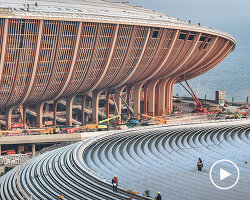saudi arabia’s mega ambitious plan for fifa world cup 2034
FIFA has unveiled details of Saudi Arabia‘s ambitious plan to host the largest-ever edition of the world cup held in a single country. This announcement follows the Kingdom’s FIFA World Cup 2034 official bid book submission at an official ceremony held in Paris. With a slogan that reads Growing. Together., the publication proposes 15 advanced stadiums spread across five host cities: Riyadh, Jeddah, Al Khobar, Abha, and NEOM. Eleven of those stadiums reveal entirely new, planned designs, like the Prince Mohammed Bin Salman Stadium by Populous in Qiddiya. As for the remaining four, the Kingdom is planning on refurbishing and expanding existing sites to accommodate new programs and public capacity. Read on as we outline the complete list of stadium designs.
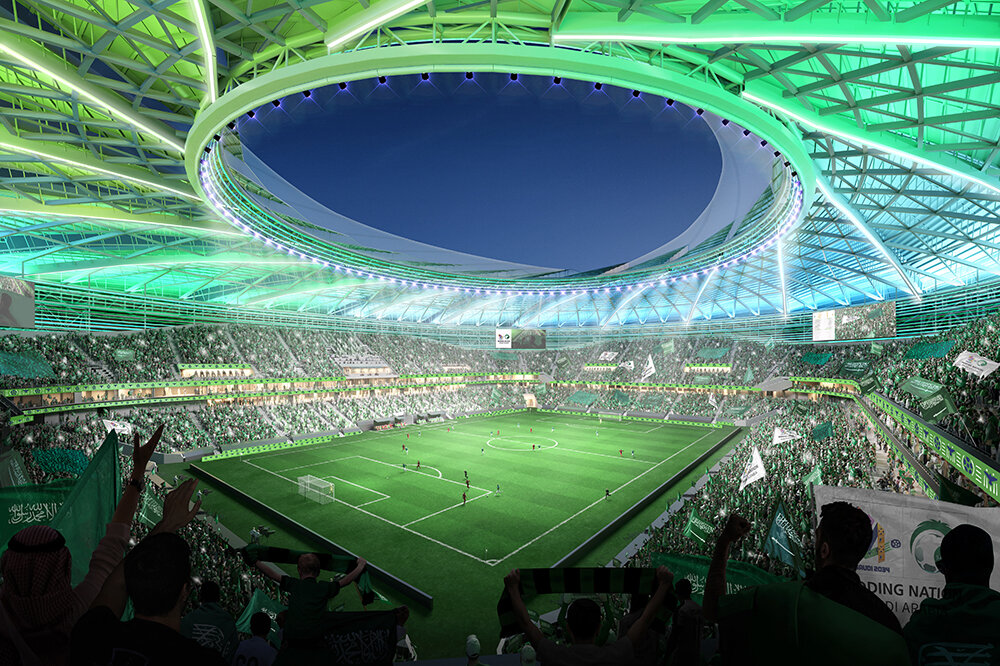
all images courtesy Saudi Arabia FIFA World Cup™ 2034 bid
explore the 15 stadium designs spread across 5 host cities
NEOM STADIUM at THE LINE
Situated within THE LINE, NEOM Stadium is expected to be one of the world’s most distinctive, iconic stadiums, with a pitch located more than 350 meters above ground to frame scenic vistas and a roof created from the city itself. It will leverage the most advanced technology for FIFA players, spectators, and broadcasters (e-ticket gates, 4K Ultra HD broadcasting, etc.) and hold a capacity of more than 45,000. The stadium will sit at the heart of a new sports-focused neighborhood adjacent to the Health and Well-Being District and the University, easily accessed from multiple levels in THE LINE.
NEOM Stadium will run entirely on renewable energy from wind and solar sources. Transportation systems will be entirely electric, with the five-minute walkability/accessibility urban model promoting travel on foot. Program-wise, the structure will be home to a men’s and women’s professional football club and a base for the club, fans, community activities, and major events.

NEOM Stadium
KING SALMAN INTERNATIONAL STADIUM in riyadh
King Salman International Stadium is designed to become the highest-capacity stadium in Saudi Arabia and a major new center for sports and recreation. With the capacity to seat 92,000 visitors, the proposal envisioned by the team at Populous will be ideal to host the opening and final matches of the FIFA World Cup 2034. The proposed design blends into its surrounding topography with the terrain and natural habitat-forming part of the stadium’s roof. Aside from its aesthetic appeal, the design will provide effective shading and ventilation tailored to the desert climate.
Situated just minutes northeast of Riyadh, close to the airport, the KSI stadium will facilitate easy local and international access and become Saudi Arabia’s official national stadium. As the highest seated-capacity stadium in the country, it will also attract and accommodate the most significant national occasions, including the largest concerts and sporting events.

King Salman International Stadium
QIDDIYA COAST STADIUM in jeddah
Also designed by Populous, the Qiddiya Coast Stadium, with a capacity of over 45,000, is designed to symbolize the dynamic relationship between people and water, energy, and matter. The design features undulating forms and a vibrant color palette reminiscent of the ripple effect of a ‘Mexican wave.’ It will be located on the northern shore of Jeddah, along the Red Sea, at the heart of the Qiddiya Coast Development. This area will also include other sports facilities and hotels within 1km. The precinct will have distinct spaces that seamlessly connect, providing ample gathering areas for fans and communities outside the stadium.
After hosting the FIFA World Cup 2034, the stadium will become a multi-purpose entertainment venue by taking out the upper tier to reduce the capacity to 25,000. With flexible features like curtains, partitions, and a removable football pitch, the venue can host esports events, exhibitions, concerts, conferences, and major sports tournaments.

Qiddiya Coast Stadium
KING FAHAD SPORTS CITY STADIUM in riyadh
King Fahad Sports City Stadium is notable for its unique fabric roof, which is inspired by traditional tents, and its elegant podium. This multi-purpose stadium serves as the home of the Saudi Arabian national football team and hosts Saudi Professional League (SPL) games, with an average attendance of around 23,000 at major events. The stadium has a seating capacity of over 58,000 and has hosted international sports tournaments and large entertainment events, including concerts and motorsports. It is set to be a venue for the AFC Asian Cup in 2027.
Plans for refurbishment by Populous aim to create an all-encompassing football city, increasing the stadium’s capacity to over 70,000. The stadium is well-integrated into the city and is located near attractions such as Wadi As-Sulai and the planned Sports Boulevard, which will provide access to green spaces and natural surroundings. Following the world cup, King Fahad Sports City Stadium will continue to serve as a multi-purpose venue for sports and entertainment, accommodating events such as football matches, concerts, festivals, and fairs.
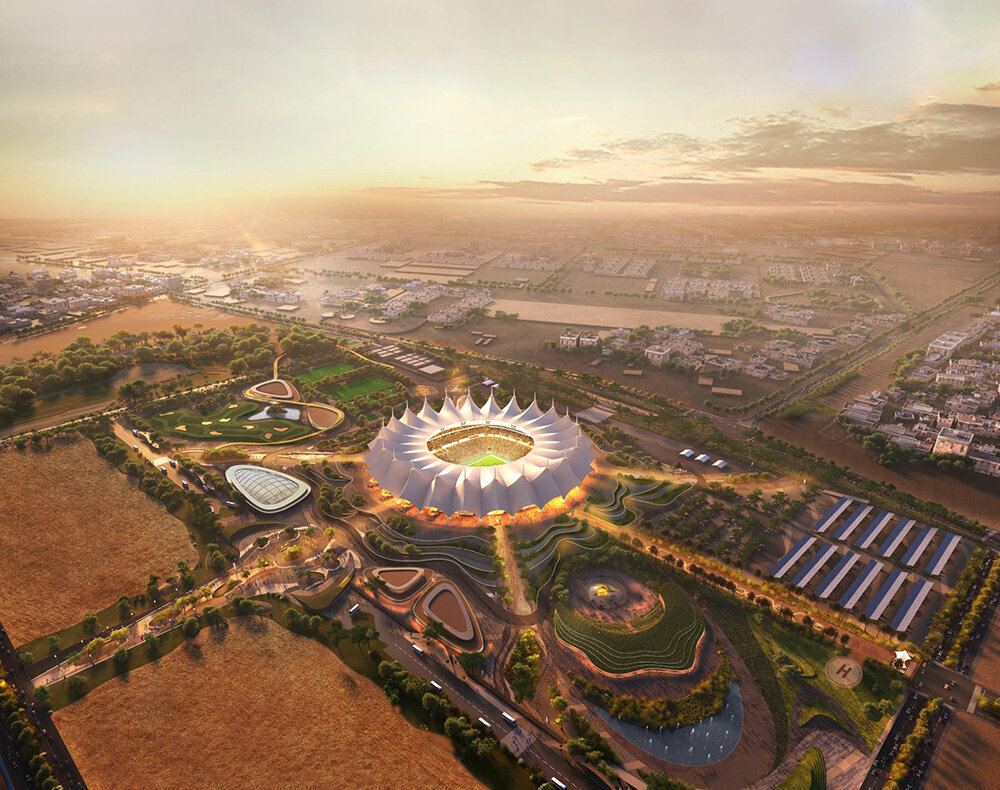
King Fahad Sports City Stadium
PRINCE MOHAMMED BIN SALMAN STADIUM in riyadh
Prince Mohammed bin Salman Stadium will be a cutting-edge facility with a capacity of over 46,000. Designed by Populous to enhance the spectator experience, the stadium features a unique three-sided bowl that offers stunning views of the Tuwaiq cliffs. The building’s futuristic look is achieved through iridescent glass, LED screens, solar panels, and perforated metal. Located about 35 km southwest of Riyadh, the stadium is part of the larger Qiddiya development, which will include a variety of sports facilities, luxury accommodations, and 58 other attractions, making it a key sports hub for the city. An extensive public transportation network, including buses and rail systems, will ensure easy access from Riyadh and the Qiddiya area.
The stadium will then permanently serve as a versatile entertainment venue, hosting professional football matches, other sports events, concerts, esports competitions, and more, thanks to its retractable pitch. The venue will also feature an Olympic Museum, celebrating the country’s Olympic and Paralympic achievements.

Prince Mohammed bin Salman Stadium
KING KHALID UNIVERSITY STADIUM in abha
King Khalid University Stadium is currently operational and has averaged around 22,000 attendees for events over the past two years. In preparation for the FIFA World Cup 2034, the stadium will temporarily expand to over 45,000 seats. Populous’ refurbishment plans will modernize infrastructure while maintaining the stadium’s historical value, including a new permanent west stand and upgraded technology. The surrounding area will also see enhancements to handle increased foot traffic, ensuring a vibrant and efficient environment.
Located southeast of Abha City on the university campus, the stadium is close to Dalaghan Park nature reserve and additional sports facilities like a sports hall, swimming pool, and basketball courts. The stadium’s post-world cup program will be tailored to a professional football club and remain available for various community and sporting events.

King Khalid University Stadium
NEW MURABBA STADIUM in riyadh
The New Murabba Stadium will seat over 45,000 people and is inspired by the layered and textured bark of the native acacia tree. It will feature the latest technology to offer a personalized fan experience, with digital signage creating customizable, immersive zones. Located in northwest Riyadh, the stadium will be accessible and welcoming to the community, with illuminated fractures serving as entry points leading to shaded ground-level areas. The roof will provide sheltered spaces for gatherings and circulation. In the long run, the stadium will accommodate concerts, gaming, and other events. Additionally, the surrounding shaded areas will promote outdoor seating and dining options.

New Murabba Stadium
ROSHN STADIUM in riyadh
The new ROSHN Stadium, located in southwest Riyadh, will have a capacity of over 45,000. Its saddle-shaped seating bowl and varying stand heights are designed to provide comfort, shade, and cross-ventilation. The bowl’s parabolic shape will enhance acoustics, creating an immersive experience for spectators. Unlike typical sports venues, the stadium aims to integrate into the urban environment, encouraging the community to explore the area. It will feature a central plaza surrounded by a lattice-like ‘crystalline’ structure that will illuminate the night sky.
Post-FIFA 2034, the stadium will become the centerpiece of a walkable community with green spaces, public squares, and amenities, promoting a culturally rich and socially connected lifestyle. The precinct will initially meet FIFA’s tournament requirements, then transition to include retail, dining, entertainment, hospitality, offices, mixed-use sports facilities, and educational spaces. It will host major tournaments, large events, and concerts.

ROSHN Stadium
KING ABDULLAH SPORTS CITY STADIUM in jeddah
The King Abdullah Sports City Stadium, built in 2014 by Arup consultancy, is Saudi Arabia’s second-largest stadium, seating over 57,000 spectators. It is home to the Al Ittihad and Al Ahli football clubs, with major events drawing an average attendance of around 46,000. The stadium will host the AFC Asian Cup in 2027 and was a key venue for the FIFA Club World Cup Saudi Arabia 2023, with an average attendance of 50,000. Nicknamed ‘The Shining Jewel’ for its distinctive geometric design, the stadium is located north of central Jeddah, near the airport. It is surrounded by extensive sports and recreational facilities, including outdoor football training pitches, an athletics track, tennis courts, a multi-purpose sports hall, a building for referees and players, and a theater.
Planned renovations in 2032 will update the stadium to meet all FIFA requirements, incorporate the latest technology and standards, and seamlessly blend with the existing architecture. After FIFA 2034, the stadium will host matches for the Saudi national team and other international football games. The entire sports city will remain a hub for sporting excellence, hosting various sports tournaments and entertainment events.

King Abdullah Sports City Stadium
ARAMCO STADIUM in al khobar
The new Aramco Stadium envisioned by the team at Foster + Partners, with a capacity of over 45,000, will be built on the Arabian Gulf’s shore. Its whirlpool-inspired design, reflecting the local Dawwama phenomenon, features overlapping sail shapes and wave motifs, harmonizing with the coastal landscape. The stadium will host the FIFA World Cup 2034 and the AFC Asian Cup 2027. Located in northern Al Khobar near the Corniche, it will be easily accessible via public transport, bike paths, and pedestrian walkways. After the World Cup, it will serve as a home for a professional football club and will include training facilities and commercial, and retail spaces. Its unique design and prime location will make it a prominent city landmark.

Aramco Stadium
SOUTH RIYADH STADIUM
The new South Riyadh Stadium by Populous, with a capacity of over 45,000, will boast a facade that combines modern elements with the area’s traditional architectural style and materials. The stadium and its surroundings are designed with sustainability in mind. The landscape will feature native, drought-resistant plants to conserve water, and rainwater harvesting systems will be installed. Solar panels will be integrated into the design to generate sustainable energy, highlighting a commitment to environmental responsibility. Located in southwest Riyadh, near Wadi Namar and its future development as part of the Green Riyadh Project, the stadium will include open spaces, marketplaces, and green areas. After the FIFA World Cup 2034, the venue will host a professional football club and various sporting and entertainment events. The stadium precinct will serve as a community hub, becoming a cherished landmark for the Wadi Namar area.
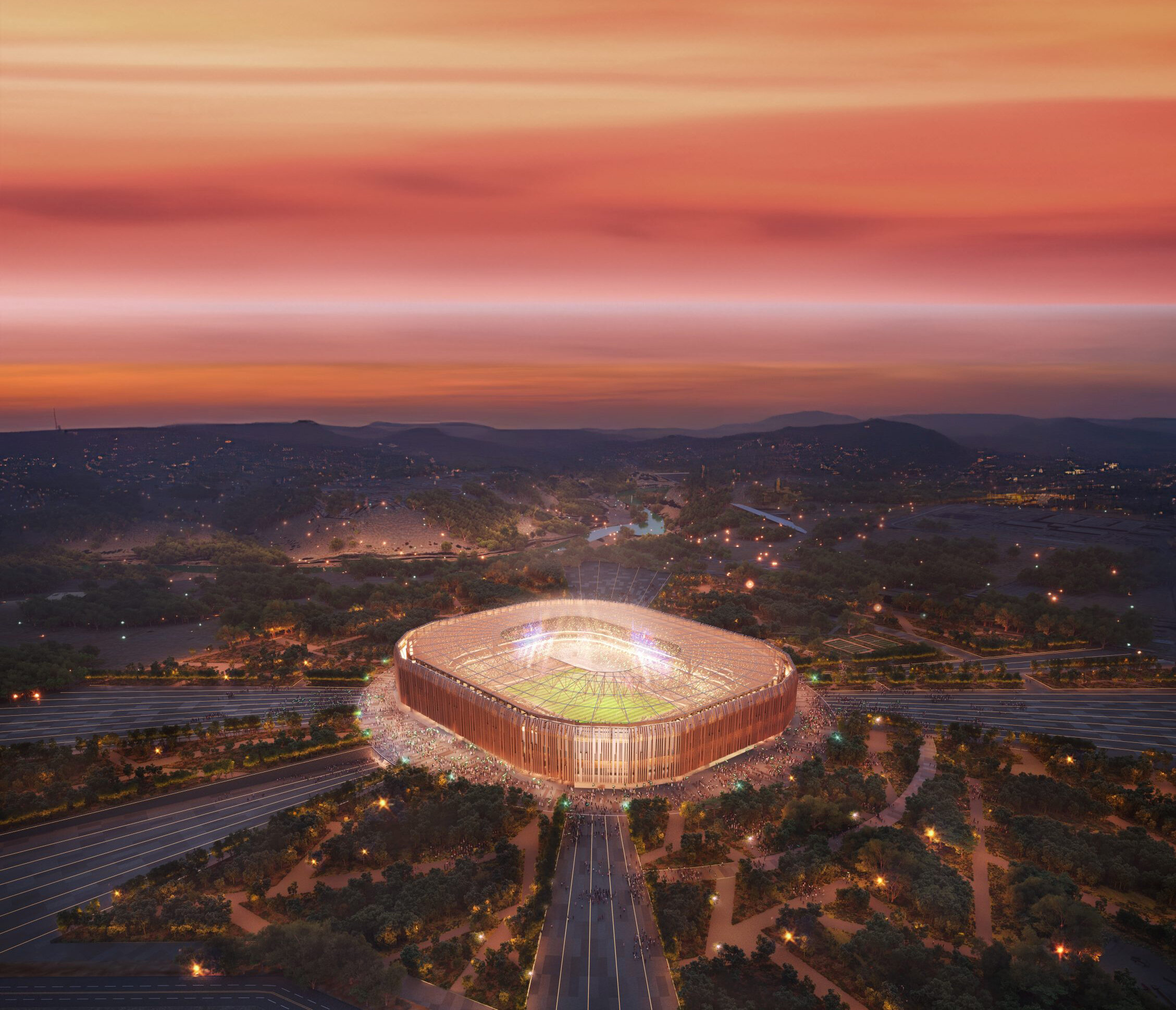
South Riyadh Stadium
KING ABDULLAH ECONOMIC CITY STADIUM in jeddah
The King Abdullah Economic City Stadium, located north of Jeddah on the Red Sea Coast, will feature over 45,000 seats. Its design, inspired by local coral reefs, emphasizes versatility and organic aesthetics. The stadium is part of a larger development aimed at economic growth, environmental sustainability, and community integration. The area will include three hotels, mixed-use spaces, and a sports clinic. After the FIFA World Cup 2034, the stadium will host football, concerts, and exhibitions. Surrounding public spaces will focus on community, with ample green areas for residents to enjoy nature.

King Abdullah Economic City Stadium
PRINCE FAISAL BIN FAHAD SPORTS CITY STADIUM in riyadh
Envisioned by Populous, the Prince Faisal bin Fahad Sports City Stadium in Riyadh will be a new multi-purpose facility inspired by Salmani architecture’s ‘culturally contextualized modernism.’ Built with locally sourced materials and equipped with energy-efficient systems, including extensive solar panels on the roof, the stadium will have a capacity of over 45,000. Located within a broader park site master plan, the stadium will serve as a central hub for community sports and mixed-use green spaces. Its convenient location near two metro lines and a bus network will provide excellent transport connectivity. Following the FIFA World Cup 2034, the stadium will become the home of a professional football club and host major matches. It will also be used for concerts, international events, and other sports tournaments, while the surrounding green spaces will be available for community leisure activities.

Prince Faisal bin Fahad Sports City Stadium
JEDDAH CENTRAL DEVELOPMENT STADIUM
German practice GMP Architecten will lead the Jeddah Central Development (JCD) Stadium, located in the coastal Al Andalus area of southwest Jeddah, which will seat over 45,000 spectators. Its design blends traditional Al Balad architecture with modern technology. It features three tiers, an outer concourse linked to four surrounding ‘villages’ (fan, leisure, retail, and educational/medical), a fully covered bowl with a semi-translucent roof, a retractable inner roof, and a 360° LED screen. The stadium will anchor the Sports Park District of JCD and, after the FIFA World Cup 2034, will host two professional football clubs and various other sporting events, conferences, exhibitions, and concerts.

Jeddah Central Development (JCD) Stadium
KING SAUD UNIVERSITY STADIUM in riyadh
King Saud University Stadium, located on the university’s campus west of Riyadh, currently serves as the home ground for the Al Nassr football club. The stadium, with a capacity of about 27,000, has the likes of SPL games, the Spanish Super Cup, and AFC Champions League matches. Over the past two years, the average attendance for major events has been around 17,000. It is set to host the AFC Asian Cup in 2027 and will be temporarily expanded by Populous to 46,000 seats for the FIFA World Cup 2034, featuring a new elliptical lightweight spoke wheel roof and enhanced amenities to meet FIFA standards.
The surrounding area includes additional sports facilities such as an arena, swimming pool, tennis court, and the U Walk mixed-use development, which offers commercial and retail spaces. After the FIFA World Cup 2034, the stadium will become the home of King Saud University’s teams and will also be used for university sports, community events, and women’s football. The upper tier will be partially removed to create a 33,000-capacity venue.
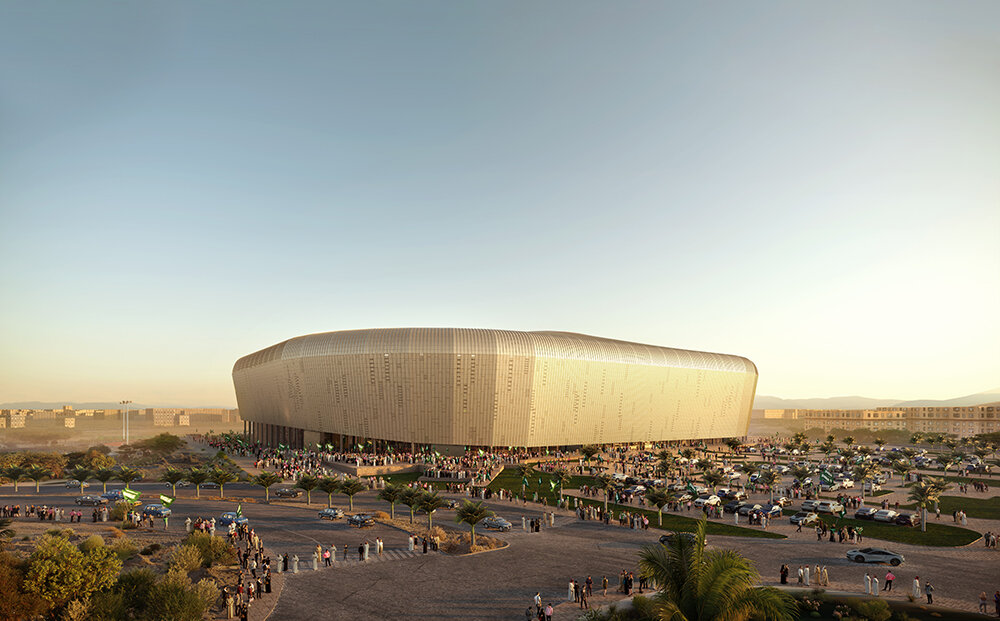
King Saud University Stadium

King Saud University Stadium
project info:
name: Saudi Arabia FIFA World Cup™ 2034 bid | @saudi2034bid
release date: August 2024






